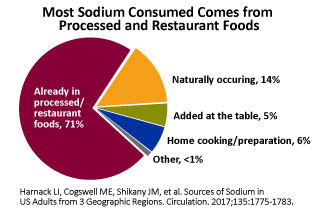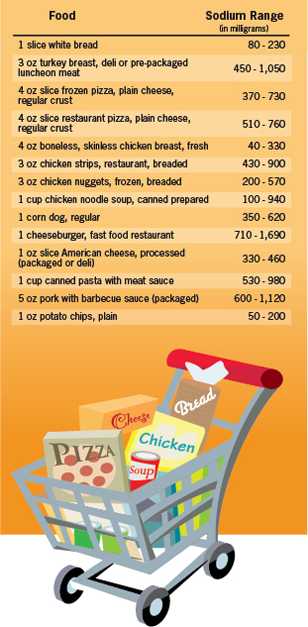Sodium and Food Sources

Some foods that seem healthy may have high levels of sodium. Unprocessed fruits and vegetables are usually low in sodium.
Most of the sodium Americans eat comes from packaged, processed, store-bought, and restaurant foods. Only a small amount comes from salt added during cooking or at the table. In fact, most Americans already get more daily sodium than recommended before they ever pick up a salt shaker.

Americans consume an average of more than 3,400 milligrams (mg) of sodium each day.2 But the 2015-2020 Dietary Guidelines for Americans recommend that Americans consume less than 2,300 mg of sodium each day as part of a healthy eating pattern. Increasing access to lower sodium food options and giving the power of choice to the consumer could help prevent millions of cases of high blood pressure and save billions of health care dollars.
What is processed food? The Dietary Guidelines for Americans define the term "processed food" includes "any raw agricultural commodity [product] that has been subject to processing, such as canning, cooking, freezing, dehydration, or milling."1 Processing certain foods can make them last longer by killing organisms in the food or slowing their growth.
Learn more about sodium's role in processed food [PDF-867K] and how to reduce sodium.
Sodium Reduction Is Challenging

- Types of food matter: More than 40% of the sodium we eat each day comes from just 10 types of foods, ranging from the number 1 source—breads and rolls—to eggs and omelets, which are 10th on the list.
- Sources of food matter: About 65% of sodium comes from food bought at retail stores, where you can look for lower sodium choices. About 25% comes from foods made in restaurants, where it can be difficult to see how much sodium is in your meal.
- Brands of food matter: Different brands of the same foods may have different sodium levels. For example, sodium in chicken noodle soup can vary by as much as 840 mg per serving.
Sodium Is Everywhere
- Foods that otherwise seem healthy may have high levels of sodium. Examples include cottage cheese and turkey breast deli meat.
- Some foods that you eat several times a day, such as bread, add up to a lot of sodium even though each serving is not high in sodium.
- Sodium is already part of processed foods when you purchase them, and it cannot be removed.
- Sodium content can surprise you. For example, before it arrives at the grocery store, raw chicken and pork can be injected with a sodium (or saline) solution which increases sodium content significantly.
- Many restaurant meals are high in sodium.
References
- The U.S. Federal Food, Drug and Cosmetic Act, Section 201, Chapter II, (gg).
- U.S. Department of Health and Human Services, U.S. Department of Agriculture. What We Eat in America [PDF-64K]. NHANES 2013-2014. Agricultural Research Service Website.
- Page last reviewed: March 28, 2017
- Page last updated: March 28, 2017
- Content source:



 ShareCompartir
ShareCompartir